Fig. 84.1
Yearly OCT publications in PubMed categorized by application
It is interesting to consider what is driving these publications and the relative breakdown into each subject area. The answer is a combination of fertile and promising research frontiers, availability of government funding, clinical needs and trials, and very importantly, the availability of commercial, regulatory approved OCT products. Certainly, ophthalmic publications would not have grown so dramatically if (1) OCT was not a promising and effective technology for ophthalmology, (2) the NIH National Eye Institute and other government agencies around the word did not provide significant funding, and (3) a commercial company did not produce a reliable and field-able product early on to provide a catalyst for the entire process. These ophthalmic publications are dominated by researchers using commercial instruments, and Zeiss released its first ophthalmic OCT product around 1996 and was the only company making such a product for a good part of a decade – the formative years of this market’s development. A similar point is also true for cardiovascular OCT. Cardiovascular/intravascular publications are currently the second largest publication category in OCT. Lightlab (acquired by St. Jude Medical in 2010) obtained its first regulatory approval in 2004. Like Zeiss, Lightlab was almost a decade ahead of other entries into this new market. Examining Fig. 84.1 around the dates of 1996 (2004) shows the start of a big increase in ophthalmic (cardiovascular) publications, in large part, as result of introduction of these new medical products into their respective markets and use by clinicians in clinical settings. These are two clear examples of the power of successful translation of technology from the research environment to the commercial environment. Not only has this resulted in many more publications because clinicians can use fully engineered and approved instruments in their studies and trials, it also dramatically accelerated bringing the technology to patient care (which improved the diagnosis and treatment of blinding ophthalmic diseases and promises similar advances for deadly cardiovascular disease), and it brought financial rewards and market share to the companies that took the business risks and were first to market.
It is interesting to speculate to what extent is publication history a bellwether for future commercial opportunities and are those commercial opportunities subject to the popular trends within funding agencies or are they matched with the best areas for potential impact. Upon examining the data, it seems that funding agencies and subsequent researcher publications do sometimes go off onto dead-end roads, but that those roads usually don’t last very long. In addition, as we will see later in this chapter, the number of startup companies and new products from existing companies seem roughly to follow the number of publications. For example, there are several companies in the process of commercializing OCT for new applications such as in the dermatology and gastroenterology markets, the next two highest ranking publication areas in the Fig. 84.1.
84.3 Patents
Patents are obviously another important component of OCT technology transfer and the OCT marketplace in general. Patents play many roles, and the motives to file them are varied. The motive for academics can be either to help enable a startup company the professor or student is involved in or to seek a share in the royalty fees by licensing to a company they are not involved in.2 Many academics that start companies have licensed patents they authored from their institution, usually under exclusive terms. Exclusive fundamental patents can be a key factor in solidifying equity financing from investors. If a technology is relatively new, patents are especially important because they protect the substantial investment that is necessary to develop and validate the technology. In addition, patents can serve as a historical record of invention, much the way peer-reviewed journal articles do. For example, MIT documented swept source OCT (SS-OCT) systems in most of its earliest OCT patents dating back to 1991, even though the first MIT SS-OCT journal publication was not submitted for publication until 1996. The motives for filing patents in industry are also diverse. Patents can be filed in an effort to provide protection from a competitor entering a market, to ensure that the company has a right to continue to produce, to generate revenue, or for other motives.
Figure 84.2 shows the number of US Patent and Trademark Office (USPTO) patents issued by year that have OCT in the title, abstract, or claims. This Figure shows three curves: the total number of patents, the number of academic patents, and the number of industry patents. It is interesting that even in the early years, industrial patents outpaced university patents. This is, in part, due to the fact that many research institutions do not have the financial resources to file large numbers of patents, and, until recently, publications, research support, and recognition at conferences were key criteria for academic career success. Now, with more emphasis on translation of technology, these criteria may change and result in more academic patents.
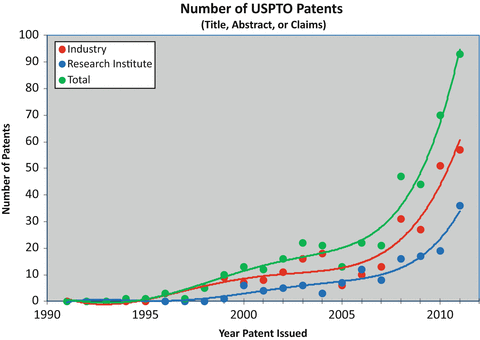

Fig 84.2
Yearly OCT USPTO issued patents
Figure 84.3 shows the cumulative number of USPTO patents that have OCT in the title; title, abstract, or claims; and the entire specification. It is clear that the number of issued patents rose initially around 1995, followed by a significant increase around 2007, and there are now over 1,000 issued patents that contain OCT in the specification for the United States and many more patents in Europe and elsewhere. As with publications, it is difficult to determine what an OCT patent is, and there are clearly other patents that do not mention the term OCT, but would impact OCT systems. For example, a patent on a rotary single-mode fiber joint could impact OCT cardiovascular and endoscopic systems, even though it may not mention the word OCT.
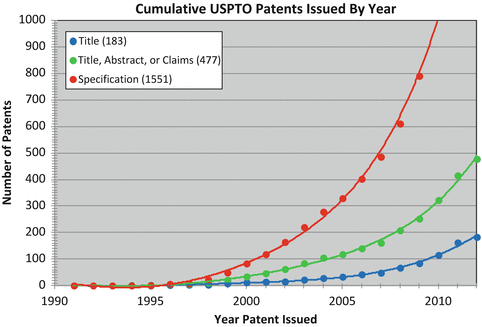

Fig 84.3
Cumulative OCT USPTO issued patents. Cumulative total since 1990 to September 2012 is shown in legend
Patents are sometimes classified as fundamental or incremental. It is very difficult to get a fundamental patent to issue now that OCT is over 20 years old. In fact, many of the fundamental patents from early years on time-domain OCT, swept source OCT, and full-field OCT systems, scanning techniques, probes, and disposables have expired or are about to expire. Thus, the many of recent patents may represent incremental patents. The role of an individual patent versus a portfolio of patents can be different in an academic setting versus an industrial setting. In an academic setting, patent filings are often focused on more fundamental ideas because it is very costly and risky for a university to develop a large portfolio of patents. Thus, university technology licensing offices will usually not file on incremental ideas. This is also, in part, due to university licensing offices expecting the licensee companies to file the incremental patents. In industry, a large patent portfolio which may contain many incremental patents can be very important to thwart potential litigation even though it can be hard to place a value on a patent portfolio that is never challenged in court.
Patents can be licensed exclusively or nonexclusively. Licenses to startup companies often are exclusive, whereas licenses to larger companies tend to have a significant fraction of nonexclusive terms [1–3]. In the United States, most university licenses to startups tend to have a combination of fees, equity (1–5 %), and royalties (1–5 %) stakes in startup companies as well as revenue and market due diligence milestones that allow the university to change the licensing terms if the company is not progressing as agreed to in the commercialization process. Often, startup companies and their investors don’t want to see precious early company cash going to university licensing offices so they often trade equity for upfront fees. Universities are becoming more stringent about restricting the fields of use to a license grantee in order to avoid situations where a license is given in a field that is never commercially developed. Startup companies and their investors often want exclusivity in the broadest fields of uses, even though this is contrary to the near-term goals of startups which must often focus on a particular market for many years in order to become successful.
It is mainly universities and “patent trolls” that license to industry.3 Licensing to industry is difficult, and the patent has to be very powerful, as industry has a strong disincentive to give up precious margin (revenue) in the face of market pressures for profitability. Furthermore, while universities typically develop multiple patents in different areas, the vast majority of the licensing revenue is in a very small percentage of their licenses and patents. It is estimated that about one in 200 university patent licenses generate in excess of $1M in any 1 year [3]. At one leading US University between ∼85 % of the total royalty and fee income came from the top ∼12 patent families. Thus the vast majority of the licensing revenue comes from a small number of big hits. It is probable that a significant fraction of university patents are never licensed at all [1–3]. Patenting law is complex and varies from country to country and over time. For example, US patent law has recently shifted from “first to invent” to “first to file.”
Recent trends suggest that patents are playing a more prominent role in the industry. There have been recent major news stories about the increasing value of industrial patent portfolios, particularly in big industries such as wireless where giants such as Apple, Motorola, Google, Microsoft, Samsung, and others are battling for market share [4]. For example, Google bought Motorola Mobility partly for its patent profile for ∼$12B in 2011. As another example Apple and Samsung have been embroiled in many patent related lawsuits around the globe, with billions of dollars in damages claimed between them. It seems unlikely in the near term that OCT patents will be this litigious, and part of the reason is Apple sells ∼$1B in iPhones per week – a long way from OCT sales volumes. In fact, there have only been a very small number of OCT patent battles. But as the revenue stakes increase, so does the likelihood of patent litigation and some of the ugliness of patent trolls and big company tactics being used against small companies [4]. For example, a small startup company is often in no financial position to litigate against an established large competitor, nor are they in a position to fight a competitor litigating against them – even if the apparent legal metrics of the cited patent infringement seem on the side of the small company. Legal battles involving patents can easily exceed $1M and that can be a big chunk of the available cash for small companies.
In summary: patents are important in the OCT technology transfer process and the OCT market in general; patents play a particularly prominent role in startup companies; it is difficult to have a fundamental patent issue after ∼25 years of technology development; a significant percentage of university patents are never licensed, the majority of value in university patents comes from a small fraction of the issued patents, and the motives for universities and industry filing patents can be quite different. It is clear that the number of research and industrial sponsored OCT patents is increasing, and this is due to many factors, including the fact that the underlying commercial market is growing, as well as the general high-tech industry-wide increase in the importance of patents.
84.4 Government Funding in OCT
The US government and other governments around the world have been large supporters of funding for research and development in OCT and its applications. This includes funding for basic science and technology as well as applications of the technology including clinical studies and trials. As with journal publications and patents, it is difficult to determine what is OCT funding and even more difficult to track down all the potential sources of OCT government funding around the world. A snapshot of some examples of government funding is shown in Fig. 84.4. This plot contains cumulative funding in OCT for US National Science Foundation (NSF), US National Institutes of Health (NIH), Canada, and the United Kingdom.4 This data assumes if “Optical Coherence Tomography” is mentioned in the title, abstract, or summary of the grant mentioned, then it was counted as an OCT grant. This data is drawn from a more comprehensive analysis contained in reference [5].
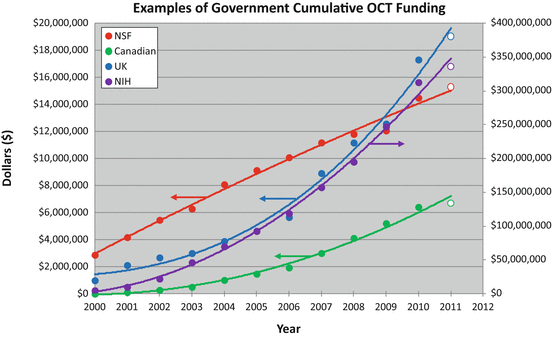

Fig. 84.4
Examples in growth of government funding in OCT. The NSF, Canadian, and UK funding are on the left vertical axis, and the NIH funding vertical axis is on the right. 2011 is a partial year’s result
Figure 84.4 illustrates several things, foremost of which is that there has been a steady increase in funding, and in aggregate, this cumulative funding approached $0.5B in the last decade. The actual total could be far in excess of this, approaching well over $1B since this analysis does not count numerous major sources of OCT funding in the United States, Europe, Japan, Russia, China, and other countries. The majority of funds shown here have come from the NIH, and within the NIH, the National Eye Institute (NEI) has accounted for much of the funding to date [5]. The NEI money has supported ophthalmic clinical studies and clinical trials, which can be expensive. One potential noteworthy trend is that NSF funding appears to be growing at a smaller rate than other sources. This does not bode well for US researchers and industry because NSF funds are better matched to fundamental technology development which is key to future innovation and commercialization.
A question arises as to whether or not this $500M to $1B of worldwide government funding has been effective. Most would say the result is an unqualified success from many metrics. OCT in ophthalmology alone has had over ∼100 M procedures, been a major sight saver, created a paradigm shift in ophthalmic practices around the world, generated over $1B in capital equipment sales, generated over $1B in reimbursement in 2010 alone, and created many jobs in the process [5]. With OCT commercialization in other clinical specialties such as cardiovascular, gastroenterology, and oncology, the return on investment and clinical impact on healthcare could continue to be impressive.
It is interesting to speculate about where OCT R&D dollars will come from in the future. In the past, the majority of funding for R&D has come from the government. But with the OCT market approaching ∼$0.5B/year it is clear that R&D from industry will begin to play a significant role just as it has in other mature industries such as microprocessors and telecommunications. In the financial statements of public and private companies, the percentage of revenue spent in R&D can vary from 15 % to 50 % or more. For mature OCT companies with established product lines, the R&D expense number is lower (∼15 %), whereas for small startup companies the number can be much higher. Assuming 20 % of a $0.4B market yields an industrial R&D expenditure of ∼$80 M/year in 2012. This is about the same level as the yearly US government-sponsored R&D spending in 2012 as seen in Fig. 84.4. Thus, the current government and industry R&D expenditures are roughly of the same magnitude.
This trend does not diminish the importance and necessity of future university research and the government funds that support it. OCT is still an emerging field, and there are large gaps between what industry will fund and the government can fund. Government funding supports new technology development, clinical research, and clinical validation studies. This support continues to be critical and highly leveraged, since industrial funds alone may not support OCT innovation in some of the most new and promising areas for the future.
In summary, the amount of cumulative government spending around the world has exceeded $0.5B, government funding has had a profound effect on the development and commercialization of OCT products, the financial return on this government spending has been outstanding, and continued government support is needed to continue to speed new applications of OCT to market to benefit patient care and commerce. Successful entry of commercial OCT products can accelerate this funding and its positive impact on commerce and clinical care, as is clearly the case in ophthalmology and cardiology.
84.5 Some Examples of Technology Transfer to the Market
Success with technology transfer and the launch of any new product line within a startup company or within an established company is extremely hard. It’s difficult and risky to hit all the milestones necessary in the marketplace: to raise funds; recruit and build a team; develop new technology, qualify it, and get regulatory clearances set up manufacturing lines, product support, and quality systems; prove value in clinical studies and clinical trials; get reimbursement; make a profit with the necessary profit margin to reinvest money into supporting existing products and R&D for new products to keep and grow market share; and return profit to the shareholders and keep workers employed. For these reasons, as mentioned previously, academic research is usually only the first 10 % of the job of commercialization, and technology translation often takes much longer and is much harder than expected.
Figure 84.5 (which is similar to that shown in references [6, 7]) shows one qualitative timeline for evolution and phases of a new medical product such as OCT. This suggests that it takes on the order of 3–5 years to design, develop, and qualify a product to enter a new market. Startups have the additional burden during this phase of developing the other aspects of their business (regulatory, sales, marketing, manufacturing, etc.). It then takes another 3–5 years for that product to gain market relevance by, for example, proving efficacy and cost savings though clinical studies and clinical trials. Beyond that, it can take another 3–5 years to ramp into significant market penetration, explore and expand into closely related markets, and face competitive pressures. To reach the end of this phase can take 10–15 years. The timeline for additional companies developing a competitive product in a market where a prior product has already received regulatory clearance and some level of market penetration can be, and usually is, much faster than that shown above. The first company often paves the way in regulatory bodies and the market at large. Thus, the second company to enter a new market gets an easier road, but has a disadvantage in the ensuing fight for market share.
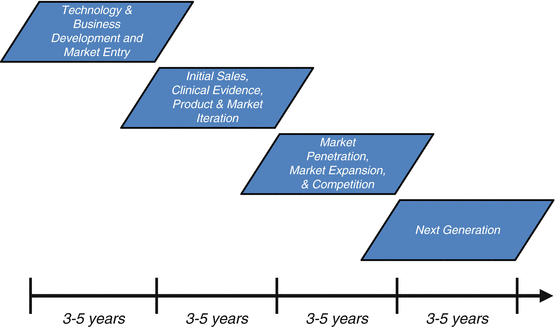

Fig. 84.5
Phases of product evolution (“five-year rule”)
Of course not every product falls into this simple phased model, but it is interesting that Advanced Ophthalmic Devices (AOD) and Lightlab Imaging which were among the first OCT companies followed this general pattern. AOD was an OCT startup founded in 1992 out of MIT and acquired by Zeiss in 1994. Lightlab Imaging was also an MIT OCT startup founded in 1998. Lightlab was acquired by Goodman Corporation in 2002 and then acquired by St. Jude Medical in 2010. It is interesting to note that both Zeiss/AOD and St. Jude/Lightlab Imaging led the next significant competitor entry into their respective markets by almost a decade. For both companies, this translated to high risk followed by high reward in obtaining a large market share. Zeiss had shipped ∼$100M’s in ophthalmic OCT products before a significant scale competitor emerged. St. Jude is currently at ∼$100 M/year run rate. Perhaps more important than the profits and market share, the successful transition of the technology had a massive impact in bringing critical diagnostic and research tools to impact clinical care for blinding ophthalmic diseases and deadly cardiovascular disease, accelerating progress by almost a decade.
Figure 84.6 illustrates how OCT in ophthalmology followed the general trend of Fig. 84.5 and further shows the high degree of correlation that makes up this ecosphere of publications, patents, government funding, companies starting OCT ophthalmic products, clinical ophthalmic procedures (based on CPT code 92135), and revenue for the ophthalmic OCT market. AOD started in 1992, and Zeiss acquired it in 1994 and released its first product in 1996 – 4 years later and within the time period shown in phase 1 of Fig. 84.5. Zeiss shipped ∼400 units of its first-generation product (OCT1/2) and gained critical clinical evidence and validation on utility, releasing its second-generation OCT product Stratus in 2002 – 6 years later and within that period shown in phase 2 of Fig. 84.5. There was significant market penetration of Stratus and then around 2007 when Zeiss and several other companies released spectral domain SD-OCT technology – 5 years later and within the time frame shown in phase 3 of Fig. 84.5. It is interesting to note that while commercialization of Fourier domain OCT technology (both SD-OCT and SS-OCT) was a major boost to OCT system utility and capability, the market penetration and clinical utility of TD-OCT had reached a significant level prior to introduction of Fourier domain OCT to the ophthalmic marketplace. While there are now many ophthalmic OCT companies, Zeiss still maintained the largest market share as of 2013.
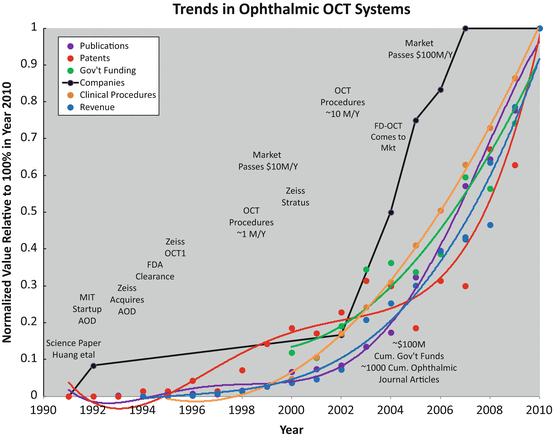

Fig. 84.6
Trends in the ophthalmic OCT system market. (The government funding shown is total NIH funding, but that funding is dominated in this time period by ophthalmology. Similarly, the patents are all OCT patents not just ophthalmology. The clinical procedures are based on Medicare data and were extracted from reference [8].) All the data are normalized to 2010
Cardiology followed a very similar trajectory as shown in Figs. 84.7 and 84.8. Lightlab Imaging (originally incorporated as Coherent Diagnostic Technology) was founded in 1998 and initially focused on the microscopy and GI markets (for Barrett’s esophagus). About a year later, the company changed direction and focused on cardiology. In 2004, Lightlab commercially released its first-generation TD-OCT cardiovascular system in Europe – 6 years later and within the phase 1 shown in Fig. 84.5. By 2005/2006, there were over 1,000 in-man clinical procedures. By 2008, there were approximately 10,000 clinical procedures. Between 2004 and 2009, intravascular OCT gained market relevance – a 5-year period commensurate with phase 2 shown in Fig. 84.5. In 2009, Lightlab released its second-generation swept source/Fourier domain (SS-OCT) cardiovascular product, and in 2013, revenue is estimated to be ∼$100M/year, and the number of cumulative clinical procedures has exceeded 100,000. This cardiovascular OCT path was very similar to that experienced in ophthalmology in that it began with a MIT startup company that was eventually acquired by a larger company, a first-generation system paved the way for understanding clinical utility and the market in general, followed by a second-generation system that increased market growth. Also, there was nearly a decade year gap before a scale competitor introduced a product into the marketplace.
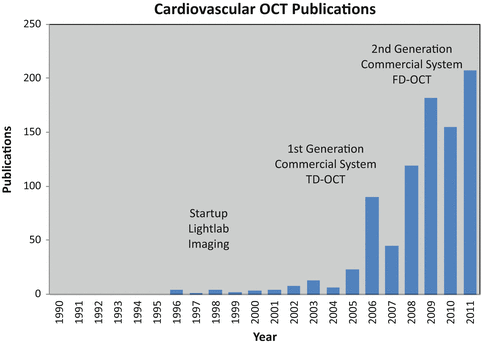
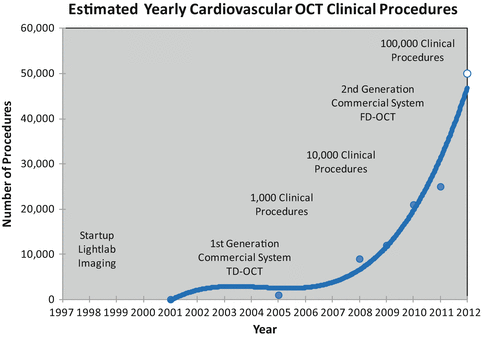

Fig. 84.7
Estimated number of cardiovascular/intravascular OCT publications

Fig. 84.8
Estimated number of cardiovascular/intravascular OCT clinical procedures. Also shown on chart are cumulative clinical procedures
Another successful example of OCT technology transfer is Optopol. Optopol was initially distributing ophthalmic equipment and producing devices such as ophthalmic projectors, refraction units, Placido ring corneal topographers, and automated perimeters. Ophthalmic OCT was an attractive market opportunity and for them. Optopol had a leading ophthalmic OCT research group close by, the Nicolaus Copernicus University (NCU). NCU researchers had received significant government funding and had a working SD-OCT clinical prototype. In 2005, an agreement between Optopol and NCU was signed. In addition to transferring technology from NCU to Optopol, the agreement also created an R&D office at NCU. The idea was to create opportunities for jobs in industry for NCU graduate students. In 2009, Canon Inc. acquired Optopol for $94M.
Bioptigen is a different example of an OCT startup. Bioptigen was founded in 2004 and is a supplier of OCT to the preclinical (small animal) and clinical ophthalmology research market, including a handheld SD-OCT product for pediatric ophthalmologists. Bioptigen has strong ties to academic work at Duke University, and Bioptigen is exclusive licensee to patent portfolios from Case Western Reserve University and Duke University. Bioptigen introduced the first commercial ultrahigh resolution UHR SD-OCT system in 2006 and received FDA clearance for the first handheld SD-OCT instrument for ophthalmology in 2012. Government sources played a strong role in funding the company. Initial funding included SBIR grants. Early on, Bioptigen had won in excess of $7M in SBIR awards directly or indirectly in partnership with others, while total equity financing is only $3.8M, none of which came from traditional venture capital. This shows the government can play a big role in both funding research and industrial activities.
There are also examples of highly successful startup companies starting with minimal academic connections and government support. A good example is Optovue. Optovue was founded in ∼2004 and was the first to get FDA approval for an ophthalmic SD-OCT system and by 2010 had revenues of ∼$50M/year. Optovue was a classic startup company and currently remains privately held. While Optovue interacts closely with academic researchers, the technology transfer relationship into Optovue was quite different in that it relied heavily on the passion and technical and business expertise of the founder, Jay Wei. He was the lead OCT engineer on the development and release of the early Zeiss OCT products.
There are many other examples of successful technology transfer from universities to startups and established companies (as shown in the Table 84.1). There are also clear examples of companies that have started organically or through association with universities that have not yet been successful from a business perspective. The poor execution is sometimes a combination of bad timing, inexperienced management and/or engineers, insufficient funding, bad choice of markets that didn’t develop or are taking a long time to develop, missed milestones, bad luck, or a combination of these and other factors. Even location can be an important factor in the success of a startup. There are several specific regions around the world that have a long track record of fostering startups; these areas have an ingrained startup culture with more risk tolerance and a local economy with access to a talent pool and industrial infrastructure and equity financing (e.g., venture capital) that can be highly beneficial to the success of young companies. These advantages are simply not available in many regions of the world. In startup companies, delays in product development or missed milestones can be deadly, as investors quickly grow impatient and compeition moves on. In large established companies, there is often a bigger financial base and other resources to buffer negative effects. Note that there is a wide range in the amount and types of funding raised by the companies listed in Table 84.1. It ranges from a few million dollars to well over $100M. To bring a successful complex medical device product to market can be quite expensive and is most often well over $10M to hit profitability. The more complex the technology, market, regulatory hurdles, and reimbursement hurdles the higher the number.
Table 84.1




Companies with OCT system products in the market or in development
Stay updated, free articles. Join our Telegram channel

Full access? Get Clinical Tree


